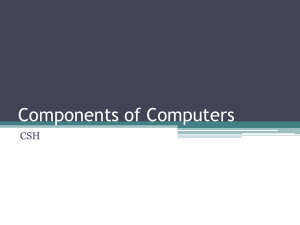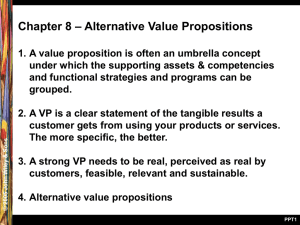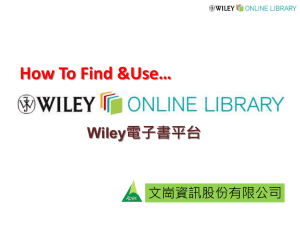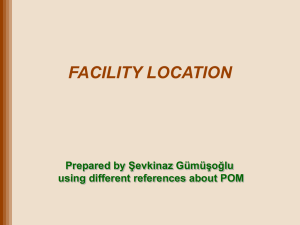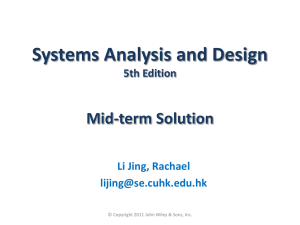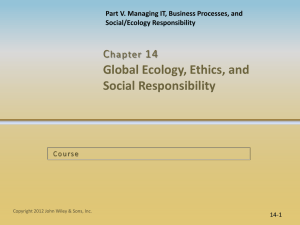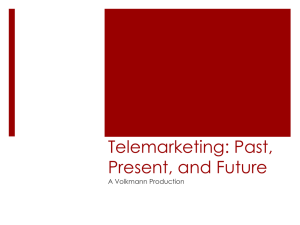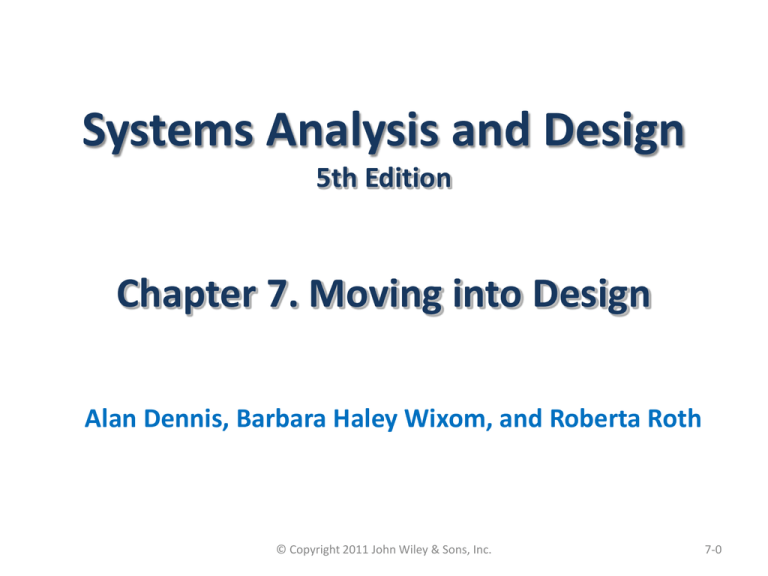
Systems Analysis and Design
5th Edition
Chapter 7. Moving into Design
Alan Dennis, Barbara Haley Wixom, and Roberta Roth
© Copyright 2011 John Wiley & Sons, Inc.
7-0
Chapter 7 Outline
Transition from requirements to design.
System acquisition strategies.
- Custom development.
- Packaged software.
- Outsourcing.
Influences on the acquisition strategies.
Selecting an acquisition strategy.
© Copyright 2011 John Wiley & Sons, Inc.
7-1
INTRODUCTION
The design phase decides how the new
system will operate.
The design phase develops the system
requirements that describe details for
building the system.
We also describe three alternative
strategies for acquiring the system.
© Copyright 2011 John Wiley & Sons, Inc.
7-2
TRANSITION FROM REQUIREMENT TO
DESIGN
The purpose of the analysis phase is to figure out
what the business needs. The purpose of the design
phase is to decide how to build it.
During the initial part of design, the business
requirements are converted into system
requirements that describe the technical details for
building the system.
System requirements are communicated through a
collection of design documents and physical process
and data models.
© Copyright 2011 John Wiley & Sons, Inc.
7-3
(cont’d)
Activities of the design phase
© Copyright 2011 John Wiley & Sons, Inc.
7-4
(cont’d)
At the end of the design phase, the final
deliverable called system specification is
created.
System specification outline
© Copyright 2011 John Wiley & Sons, Inc.
7-5
SYSTEM ACQUISITION STRATEGIES
There are three primary ways to
approach the creation of a new system:
1. Develop a custom application in-house.
2. Buy a packaged system and (possibly)
customize it; and
3. Rely on an external vendor, developer,
or service provider to build or provide
the system.
© Copyright 2011 John Wiley & Sons, Inc.
7-6
Custom Development
Custom development – building a new system
from scratch.
Pros of custom development:
- It allows developers to be flexible and creative in
the way they solve business problems.
- It allows to take advantage of current
technologies that can support strategic efforts.
- It builds technical skills and functional knowledge
within the organization.
© Copyright 2011 John Wiley & Sons, Inc.
7-7
(cont’d)
Cons of custom development:
- It requires a dedicated effort that include
long hours and hard work.
- It requires a variety of skills, but high skilled
IS professionals are difficult to hire and
retain.
- The risks associated with building a system
from the ground up can be quite high.
© Copyright 2011 John Wiley & Sons, Inc.
7-8
Packaged Software
Many organizations buy packaged software that has
been written for common business needs.
It can be much more efficient to buy programs that
have already been created and tested, and a
packaged system can be bought and installed quickly
compared with a custom system.
Packaged software can range from small singlefunction tools to huge all-encompassing system such
as ERP (enterprise resource planning) applications.
© Copyright 2011 John Wiley & Sons, Inc.
7-9
(cont’d)
One problem of packaged software is that companies
utilizing packaged software must accept the
functionality that is provided by the system.
Most packaged applications allow for customization
or the manipulation of system parameters to change
the way certain features work.
A custom-built add-on program that interfaces with
the packaged application, called a workaround, can
be created to handle special needs.
© Copyright 2011 John Wiley & Sons, Inc.
7-10
(cont’d)
Systems Integration refers to the process of
building new systems by combining packaged
software, existing legacy systems, and new
software written to integrate them.
The key challenge in systems integration is
finding ways to integrate the data produced by
the different packages and legacy systems.
© Copyright 2011 John Wiley & Sons, Inc.
7-11
Outsourcing
Outsourcing means hiring an external vendor,
developer, or service provider to create or
supply the system.
Outsourcing firms called application service
providers (ASPs) supply software applications
and/or services over the Internet.
Software as a service (SaaS) is an extension of
the ASP model.
Outsourcing has many advantages such as a
low cost of entry and a short setup time.
© Copyright 2011 John Wiley & Sons, Inc.
7-12
(cont’d)
Risks of outsourcing:
– Compromising confidential information
– Losing control over future development
– Losing important skills of in-house
professionals.
You should never outsource what you do
not understand.
Carefully choose an outsourcing firm
with a proven track record.
© Copyright 2011 John Wiley & Sons, Inc.
7-13
(cont’d)
Three types of outsourcing contracts:
- Time and arrangements: pay for
whatever time and expenses are needed
to get the job done.
- Fixed-price contract
- Value-added contract: the outsourcer
reaps some percentage of the completed
system’s benefits.
© Copyright 2011 John Wiley & Sons, Inc.
7-14
(cont’d)
Outsourcing Guidelines
© Copyright 2011 John Wiley & Sons, Inc.
7-15
INFLUENCES ON THE ACQUISTION
STRATEGY
Project characteristics that influence the choice
of acquisition strategy
© Copyright 2011 John Wiley & Sons, Inc.
7-16
Business Need
If the business need for the system is
common and the technical solutions
already exist, packaged software is a
solution.
A custom solution should be explored
when the business need is unique.
Outsourcing is used in situations where
the business need is not a critical
element of company strategy.
© Copyright 2011 John Wiley & Sons, Inc.
7-17
In-House Experience
If in-house experience exists for all
the functional and technical needs of
the system, it will be easier to build a
custom application.
A packaged system may be a better
alternative for companies that do not
have the technical skills to build the
desired system.
© Copyright 2011 John Wiley & Sons, Inc.
7-18
Project Skills
The skills that are applied during
projects are either technical (e.g.,
SQL) or functional (e.g., e-commerce).
Different design alternatives are more
viable, depending on how important
the skills are to the company’s
strategy.
© Copyright 2011 John Wiley & Sons, Inc.
7-19
Project Management
Custom applications require
excellent project management and a
proven methodology.
There are so many things that can
push a project off track, such as
funding obstacles, staffing, and
overly demanding business users.
© Copyright 2011 John Wiley & Sons, Inc.
7-20
(cont’d)
The project team should choose to
develop a custom application only if it is
certain that the underlying coordination
and control mechanisms will be in place.
Packaged and outsourcing alternatives
also must be managed; however, they
are more shielded from internal
obstacles.
© Copyright 2011 John Wiley & Sons, Inc.
7-21
Time Frame
When time is a factor, the project team
should probably start looking for a
system that is already built and tested.
If a custom alternative is chosen, and the
time frame is very short, consider using
techniques like timeboxing to manage
the problem.
An outsourcing solution could take as
long a custom development initiative.
© Copyright 2011 John Wiley & Sons, Inc.
7-22
SELECTING AN ACQUISITION
STRATEGY
To implement the strategies, additional
information is needed.
- What tools and technologies are needed for a custom
development project?
- What vendors make products that address the project
needs?
- What service providers would be able to build this
application if outsourced?
One helpful tool is the request for proposal
(RFP), a document that solicits a formal
proposal from a potential vendor, developer,
or service provider.
© Copyright 2011 John Wiley & Sons, Inc.
7-23
(cont’d)
RFPs describe in detail the system or service
that is needed, and vendor respond by
describing in detail how they could supply
those needs.
For smaller projects with smaller budgets, a
request for information (RFI) may be
sufficient, as it is shorter and less detailed.
When a list of equipment is so complete that
the vendor needs only provide a price, a
request for quote (RFQ) may be used.
© Copyright 2011 John Wiley & Sons, Inc.
7-24
Developing an Alternative Matrix
The alternative matrix combines several
feasibility analyses into one matrix.
It contains technical, economical and
organizational feasibilities for each
system candidate, pros and cons, and
other information.
The matrix is a grid with alternatives
across the top and different criteria along
the side.
© Copyright 2011 John Wiley & Sons, Inc.
7-25
(cont’d)
Sometimes, weights and scores are
added to create a weighted alternative
matrix.
The score assigned is a subjective
assignment.
To avoid a biased analysis, each analyst
develops ratings independently.
© Copyright 2011 John Wiley & Sons, Inc.
7-26
(cont’d)
Sample Alternative Matrix Using Weights
© Copyright 2011 John Wiley & Sons, Inc.
7-27
SUMMARY
Transitioning from requirements to
design
- The design phase develops the blueprint for the
new system.
- The main deliverable from the design phase is the
system specification.
System acquisition strategies
- Custom application in-house.
- Packaged system.
- Outsourcing.
© Copyright 2011 John Wiley & Sons, Inc.
7-28
(cont’d)
Influences on acquisition strategy
- Each acquisition strategy has its strengths and
weaknesses.
- Consider such issues as the uniqueness of business
need, in-house experiences, and the importance of
project skills.
Selecting a acquisition strategy
- An alternative matrix can help the design team make the
decision regarding the specific acquisition strategy.
- The request for proposal and request for quote are ways
to gather accurate details regarding the alternatives.
© Copyright 2011 John Wiley & Sons, Inc.
7-29
Copyright 2011 John Wiley & Sons, Inc.
All rights reserved. Reproduction or translation of this work
beyond that permitted in Section 117 of the 1976 United States
Copyright Act without the express written permission of the
copyright owner is unlawful. Request for further information
should be addressed to the Permissions Department, John Wiley
& Sons, Inc. The purchaser may make back-up copies for his/her
own use only and not for redistribution or resale. The Publisher
assumes no responsibility for errors, omissions, or damages,
caused by the use of these programs or from the use of the
information contained herein.
© Copyright 2011 John Wiley & Sons, Inc.
7-30


